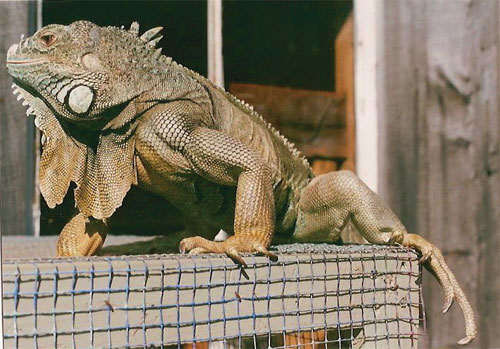Bonus content from the December 2009 REPTILES magazine article "Going Green."
 1. Gentle, patient handling is essential for baby green iguanas. Their toes, limbs and tails can be easily broken, causing much pain.
1. Gentle, patient handling is essential for baby green iguanas. Their toes, limbs and tails can be easily broken, causing much pain.
2. Imagine switching places with your young iguana; think what it’s like to be picked up by a giant. When you hold a small green iguana up to your face, it sees your mouth move, hears your voice, feels your breath and probably thinks it’s about to be eaten. Young iguanas need time to get used to people.

Photo by Wendy Townsend.
The author’s green iguana Spot lived to be 24 years old.
3. Green iguana “personalities” and tolerances for handling vary. Taming and handling techniques vary, too. Some references below have some great tips.
4. Green iguanas do not bite without a reason. And no matter how tame, iguanas are wild animals. You must respect their warning signals or risk being bitten. If a male perceives a pheromonal smear on your hand or face, his drive to react aggressively can override whatever familiarity there is in your relationship with him. In 40 years of keeping iguanas I have been bitten twice. Both were by green iguanas, and both times I was being careless.
5. Watching head and body language and making eye contact with my lizards lets me know how they’re feeling. If a green iguana’s eyes are wide open, if its body is laterally compressed, its tail twitching, its dewlap pushed out, I can be sure that it feels agitated or threatened. I should back away or approach with great caution.
6. Spend time with your green iguanas. The more you learn about these lizards and their ways, the more confident you will be in keeping and handling them.
7. You can never know enough about green iguanas. Below are 11 references to learn more about these lizard companions.
- Bagnall, Gary. “Making Sense of Reptile Lighting.” REPTILES magazine. January 2004.
- Binns, John. “The Essential Iguana: Your guide to rhinoceros iguana care.” REPTILES magazine. January 2009.
- Barten, Stephen L. “Green Iguana Management and Husbandry.” IGUANA. Volume 10, Issue 4.
- MacCargar, Bob. “Iguanas and Artificial Ultraviolet Light.” IGUANA. Volume 10, Issue 3.
- Hayes, William K. “What Do Wild Iguanas Eat?” Iguana Times. Volume 4, Issue 3.
- Frye, Dr. Frederic L. Iguana Iguana: Guide for Successful Captive Care. Krieger Publishing Company. 1995.
- de Vosjoli, Philippe. The Green Iguana Manual. Advanced Vivarium Systems. 1992.
- Burghardt, G.M. and A.S. Rand (Eds.). Iguanas of the World. Noyes Publications. 1982.
- Hatfield, James W. Green Iguana: The Ultimate Owner’s Manual. Dunthorpe Press. 1996.
- Baines, Francis M. “Catching Wavelengths: How Natural and Artificial Lighting Affects Reptiles.” REPTILES magazine. May 2009.
- Melissa Kaplan’s Herp Care Collection.
Want to read the full story? Pick up the December 2009 issue of REPTILES, or subscribe to get 12 months of articles just like this.



